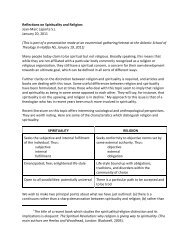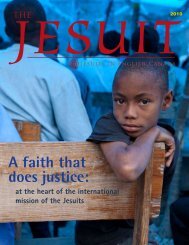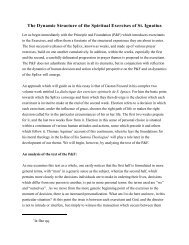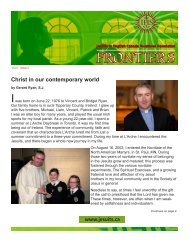Understanding the spiritual journey: from the classical tradition to the ...
Understanding the spiritual journey: from the classical tradition to the ...
Understanding the spiritual journey: from the classical tradition to the ...
Create successful ePaper yourself
Turn your PDF publications into a flip-book with our unique Google optimized e-Paper software.
documented, though some thought patterns are similar. However he was acquainted with <strong>the</strong>received terminology of purgative/illuminative/unitive ways. 19 Both were urban people,belonging <strong>to</strong> a religious order which had a clear apos<strong>to</strong>lic bent. Richard was a canon regular,and his life orbited around his abbey. Ignatius was a clerk regular, and his life, especially inearlier years, was that of a pilgrim. Ra<strong>the</strong>r than dependency could <strong>the</strong>re be parallelism: out ofsimilar experiences and contexts <strong>the</strong>y came up with <strong>the</strong> same movement away <strong>from</strong> a tripartite<strong>to</strong> a quadripartite division for <strong>the</strong> <strong>spiritual</strong> <strong>journey</strong>.Ignatius does not give us a general treatise on <strong>spiritual</strong> progress but <strong>the</strong> framework for aretreat experience. His focus is narrower than that of <strong>the</strong> texts we have studied thus far: notjust how <strong>to</strong> progress in <strong>the</strong> love of God, not just how <strong>to</strong> be permeated by that love as it calls us<strong>to</strong> reenter <strong>the</strong> world with compassion, but more precisely how <strong>to</strong> make well-ordered decisionson how specifically one is <strong>to</strong> serve <strong>the</strong> Lord. Entering in<strong>to</strong> God’s compassionate care forhumanity is not added as a fourth stage; it is, as we will see, at <strong>the</strong> heart of Ignatius’ <strong>spiritual</strong>process. In addition Ignatius stands out because of <strong>the</strong> centrality he gives <strong>to</strong> Jesus Christ in hisfour weeks. Christ was present in <strong>the</strong> earlier accounts of <strong>spiritual</strong> progress in <strong>the</strong> WesternChurch; in Richard’s four degrees he plays a role in structuring <strong>the</strong> degrees as we move <strong>from</strong><strong>the</strong> third degree (Christ being in <strong>the</strong> form of God) <strong>to</strong> <strong>the</strong> fourth (Christ taking on <strong>the</strong> form of aslave); <strong>the</strong> Exercises are seen as even more chris<strong>to</strong>centric, especially if we note <strong>the</strong> role <strong>the</strong>earthly and risen life of Jesus plays in <strong>the</strong> second <strong>to</strong> <strong>the</strong> fourth weeks.3.1 The dynamic of <strong>the</strong> four weeks: Again we will use a diagram (on <strong>the</strong> next page) as anaid <strong>to</strong> explain <strong>the</strong> progression envisaged by Ignatius. You will readily notice <strong>the</strong> four columnswhich divide up <strong>the</strong> diagram, and <strong>the</strong> row, at <strong>the</strong> <strong>to</strong>p of <strong>the</strong> second block of <strong>the</strong> diagram, withFirst, Second, Third, and Fourth Week. Immediately beneath that row you will find a <strong>tradition</strong>aldescription in Latin (italic script) of what <strong>the</strong> four weeks are about, with an English translation(regular script). We will begin <strong>the</strong>re with our explanation of <strong>the</strong> dynamic of <strong>the</strong> four weeks.3.1.1 To reform what is deformed: The first week of <strong>the</strong> Exercises, as Ignatius himselfindicates, is <strong>the</strong> stage for beginners and features purgation. Exercitants come <strong>to</strong> it with <strong>the</strong>irburden of sin and disordered attachments. They may be in need of a profound conversion <strong>from</strong><strong>the</strong> disordered attachments which have enticed <strong>the</strong>m away <strong>from</strong> God; or <strong>the</strong>y may want <strong>to</strong> reenter<strong>the</strong> conversion space so as <strong>to</strong> give <strong>the</strong>ir <strong>spiritual</strong> life a greater impetus. Thus <strong>the</strong>y comewith what is deformed in <strong>the</strong>ir being, and <strong>the</strong>y open <strong>the</strong>mselves <strong>to</strong> <strong>the</strong> grace of reformation.19 ICf. SpExx # 10, where he links <strong>the</strong> first week <strong>to</strong> <strong>the</strong> purgative way, <strong>the</strong> second <strong>to</strong> <strong>the</strong>illuminative. One will note that he does not mention <strong>the</strong> unitive way. Such reference was not called forin this particular part of <strong>the</strong> SpExx. One may offer ano<strong>the</strong>r hypo<strong>the</strong>tical reason: Ignatius may not haveworked out how <strong>to</strong> relate <strong>the</strong> unitive way <strong>to</strong> <strong>the</strong> last two weeks of his Exercises.










